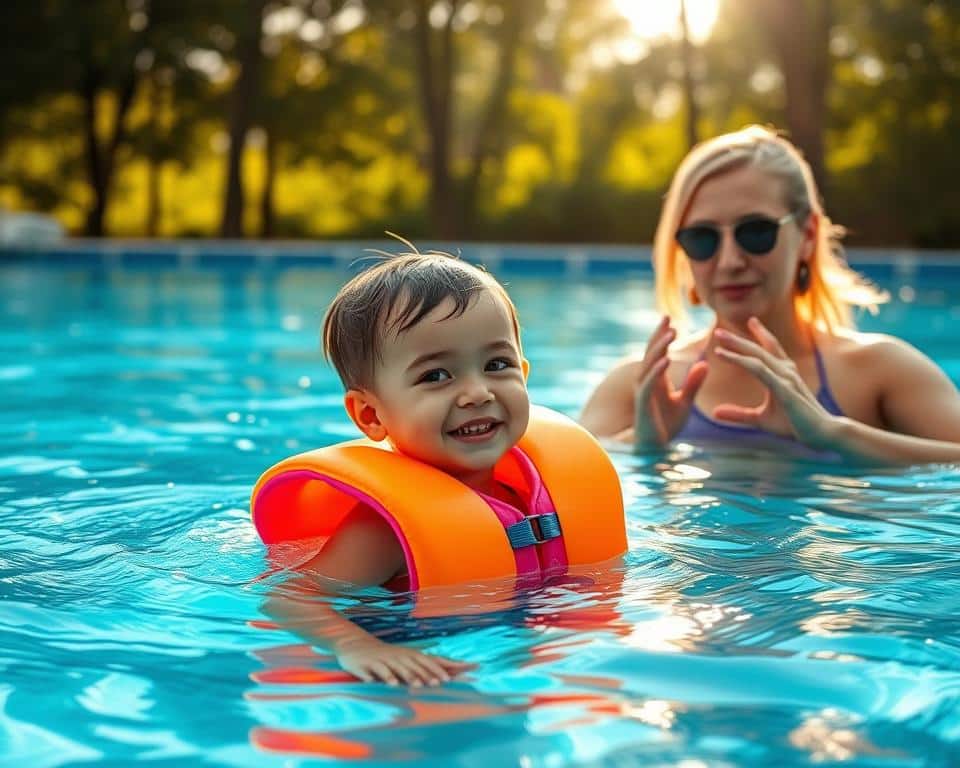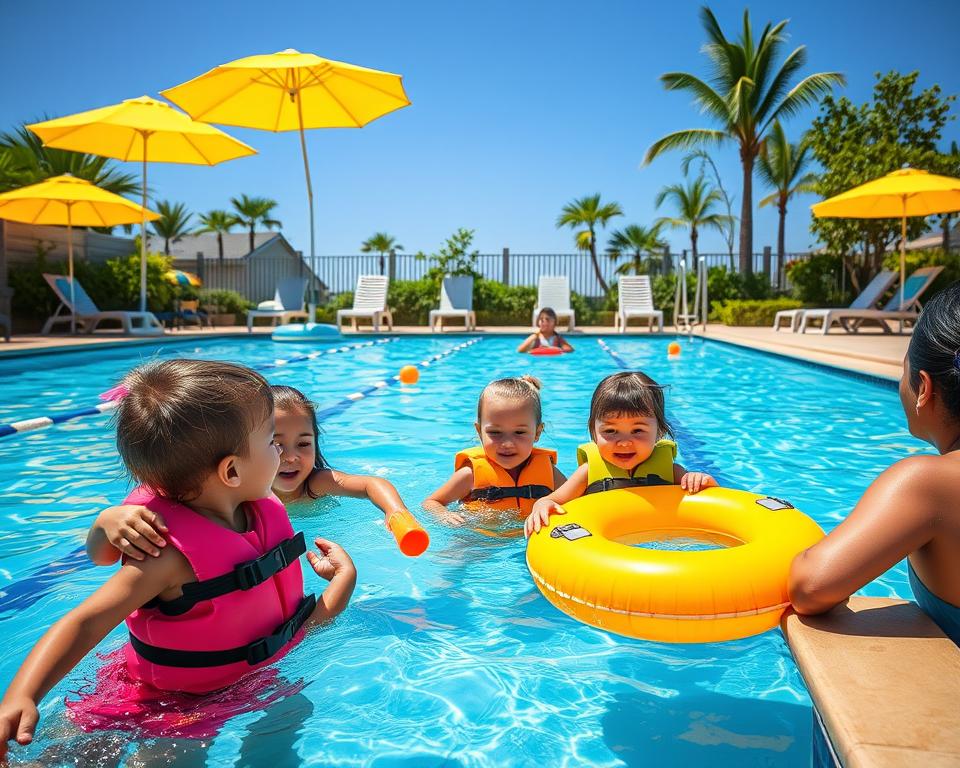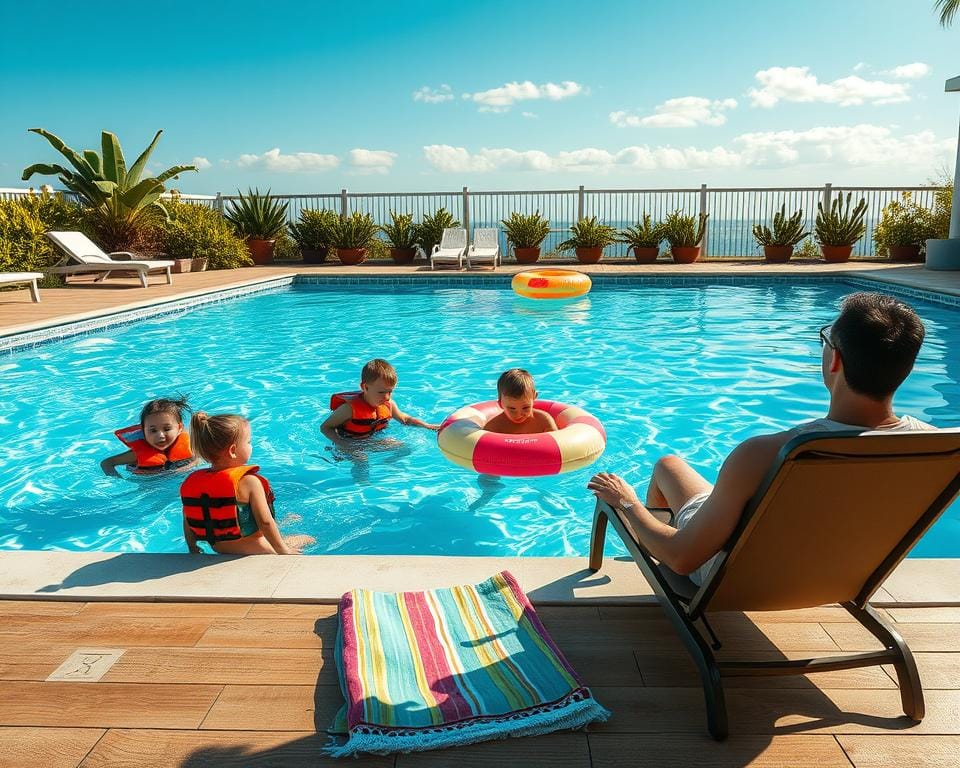Keeping your kids safe around water is essential. Drowning is a top cause of death for young kids. Following good water safety practices can help prevent child drowning.
It’s wise to learn from the American Red Cross safety tips. William D. Ramos, Ph.D., says focusing on water safety builds kids’ confidence and good habits.
Key safety tips include watching kids closely, teaching them to swim, and keeping them away from water when unsupervised. Studies show swimming lessons greatly reduce drowning risks for little ones. Also, kids in bright swimsuits like neon orange and pink are easier to see underwater.
Proactive steps are crucial in aquatic safety. Knowing key water safety tips can be a game-charger. For more detailed safety advice, look at this resource aimed at helping parents.
Each year in the U.S., thousands drown or nearly drown. Installing pool alarms and fences, giving kids swim lessons, and constant supervision help prevent such tragedies. Our dedication to these safety tips can protect our kids from drowning risks.
The Importance of Supervision Around Water
Keeping children safe near water is very important for parents. Drowning is the top accidental death cause in kids under five. Adult supervision is vital. By being vigilant, assigning watching roles, and securing the pool, we can greatly improve water safety.
Constant Supervision
Having an adult always watching is key for water safety. This adult must know how to swim and perform CPR. They watch children near water all the time. In seconds, a quiet and quick drowning can happen to young kids. Therefore, I follow the advice of the Escondido WARN campaign and the “Safer 3” rule: Safer Kids, Safer Water, Safer Response.
The Role of Designated Water Watchers
Choosing a dedicated water watcher works well for constant watching. This person only watches the kids, with no distractions. Taking turns among several adults helps keep an eye on the water without breaks. It’s especially good at busy events where it’s easy to get distracted.
Unsupervised Access Prevention
It’s very important to stop kids from getting to pools alone. Fences with gates that close and lock by themselves help a lot. The CDC says these can really lower drowning risks by controlling pool access. Door alarms also warn adults if kids go to the pool area without notice.
- Install four-sided pool fences
- Fit self-closing, self-latching gates
- Equip doors with alarms
| Supervision Method | Benefits |
|---|---|
| Constant Adult Supervision | Responsive oversight, immediate intervention |
| Designated Water Watcher | Focused attention, reduced risk of incidents |
| Safety Barriers | Prevents unsupervised access, adds a physical layer of protection |
To ensure child safety near water, parents need to be always watchful, choose reliable water watchers, and use safety barriers for pools. Every step taken towards these actions helps keep kids safe from water dangers.
Teaching Kids Essential Swimming Skills
Drowning is a top cause of injury-related death among kids. So, it’s critical to teach them how to swim early on. The American Academy of Pediatrics (AAP) suggests swim lessons are crucial. They recommend starting lessons for many kids as young as one year old. We’ll look into starting lessons early, what skills kids need, and how to pick the right programs.
Starting Early with Swimming Lessons
Studies show that swim lessons can greatly lower drowning risks for kids aged 1-4. Starting lessons early builds essential swimming skills. It also gets kids used to the water. For instance, the Consumer Product Safety Commission found that 69% of children under five who drowned were not expected to be in the water. Early swimming lessons can greatly improve water safety for kids.

Basic Swimming Skills Every Child Should Know
Kids must learn basic water survival skills. These include:
- Submergence: Getting used to being underwater.
- Floating: Learning to float on their back, a lifesaving skill.
- Gliding: Learning how to move effortlessly through water.
- Kicking: Gaining the strength to move forward.
- Getting to an Exit Point: Knowing how to find safety.
By age 5 or 6, kids in swim lessons usually can do the front crawl. This adds more skill and confidence in the water.
Choosing the Right Swim Programs
It’s vital to pick swim lessons that fit your child’s needs. Consider their comfort with water, their emotional maturity, health, and physical abilities. Some places offer scholarships for swim lessons. It’s also good to find programs with warm water for young kids, ideally between 87 and 94 degrees Fahrenheit. Picking the right program ensures kids learn in a safe, supportive environment.
Here’s a quick guide to choosing a swim program:
| Factor | Details |
|---|---|
| Child’s Comfort | Choose programs where your child feels safe in water. |
| Instructor’s Expertise | Find experienced, certified instructors who understand kids. |
| Water Temperature | Ideal for toddlers: 87 to 94 degrees Fahrenheit. |
| Class Size | Smaller classes mean more attention and faster learning. |
| Parent Involvement | Some programs let parents help, which can enhance learning. |
Considering these factors helps parents choose the best swim lessons for their child’s needs.
The Right Gear: Life Jackets and Swim Aids
It’s vital to equip your kid with the right gear for water safety. Drowning is a major risk for young children. Knowing about lifesaving gear and how to use swim aids is key.
U.S. Coast Guard Approved Life Jackets
Life jackets approved by the U.S. Coast Guard greatly lower drowning risks. A report in 2021 showed 83% of drownings during boating happened to those not wearing life jackets. Kids under 13 on boats must wear them by law. They are crucial for several water activities.
In Ohio, life jackets are a must for personal watercraft, water-skiing, or kids under 10 on smaller boats.
Understanding the Limitations of Swim Aids
Swim aids like armbands and vests offer extra support but aren’t failsafe. They can’t replace the need for adult supervision. Experts warn against certain flotation devices. They cite risks like exhaustion and the danger of drowning.
Puddle Jumper flotation devices, despite being U.S. Coast Guard approved, raise some safety concerns for regular swimming.
Appropriate Swimwear Colors for Visibility
Choosing brightly colored swimwear can help keep kids visible in water. Neon orange and pink stand out, unlike dark or pastel colors. This is crucial for quickly spotting a child in distress.
For more tips on water safety and lifesaving devices, visit essential tips for parents.
Water Safety Tips for Kids in Pools
Ensuring the safety of children around pools is crucial. Comprehensive measures can help avoid accidents. Pool fences, clear rules, and CPR training are key steps.
Pool Fences and Gates
Install a strong barrier as a first shield against pool accidents. The California Governor’s Office of Emergency Services says fences should be at least four feet tall. Self-latching gates that close by themselves are vital for safety. Alarms on pool area doors add an extra layer of protection.

Pool Rules for Children
Setting clear rules is important for pool safety. Key rules include no running, no shallow dives, and adult supervision. Rescue gear and phones should be near the pool.
Telling kids about these rules can help prevent accidents.
Importance of Knowing CPR
Knowing CPR is critical in an emergency. Adults should learn CPR to tackle drowning scenarios. This knowledge lets you help fast, before professional aid arrives.
The American Academy of Pediatrics advises all caregivers to learn CPR. This boosts emergency response times.
- Understanding the differences between swimming pools and open water is key for safety planning.
- Teach kids firm pool safety rules like no running and adult supervision to keep the pool safe.
- Everyone near the pool should consider learning CPR to face emergencies effectively and save lives.
| Water Safety Measure | Details |
|---|---|
| Pool Fence | At least four feet tall with self-latching gates to prevent unguarded access. |
| Pool Rules | No running, no diving in shallow ends, and always under adult watch. |
| CPR Training | Essential for all adults to help in emergencies and perform life-saving acts. |
Open Water Safety: Lakes, Rivers, and Oceans
Swimming in lakes, rivers, and oceans is different from pool swimming. The currents and tides in these waters are unpredictable. This makes them dangerous. It’s important to teach children to swim in places meant for swimming. This helps keep them safe from things like rocks, marine life, and deep water.
Swimming in Designated Areas
Make sure kids swim where lifeguards can see them and the area is marked. Safe swim spots have fewer dangers like hidden rocks and animals. Staying in these areas cuts down the risk of getting hurt.
Understanding Currents and Tides
Dealing with currents in water can be scary, especially for kids. It’s important to know about dangerous currents to stay safe. If caught in a current, teach children to swim parallel to the shore to get out.
Never Swimming Alone
The buddy system is a key rule for swimming in open water. Kids should always be close to an adult. Having a “water watcher” means someone is always keeping an eye out, which helps prevent accidents.
There are differences between swimming in pools and natural waters. Understanding these can help kids and parents be ready for swimming in open waters. Taking safety steps makes swimming in lakes, rivers, and oceans much safer and more fun.
| Aspect | Pools | Open Water Bodies |
|---|---|---|
| Risk of Fatigue | Lower | Higher |
| Injury Risk from Objects | Lower | Higher |
| Water Temperature | Controlled | Variable |
| Infection Risk | Controlled | Higher |
| Supervision Necessity | High | Very High |
Recognizing and Responding to Signs of Drowning
It’s very important for parents and caregivers to recognize drowning signs. Sadly, about 10 deaths from drowning happen every day in the USA. Children under 14 make up one in five of these victims. Drowning can be hard to spot. A child might gasp for air or seem like they’re trying to climb an invisible ladder. They may also be stuck, unable to move in the water. These signs are often not obvious because there’s no big splashing or loud cries for help. Knowing these signs and acting quickly is critical for child swimmer safety.
The moment a child shows drowning signs, you must act. The American Red Cross says first, look in the water if a child is missing. If you find them in trouble, you need to know what to do:
- Immediately call for emergency services for professional support.
- If you know how, give CPR (Cardiopulmonary Resuscitation) and use an AED (Automated External Defibrillator) if one is available.
- Keep checking and supporting the child’s breathing and circulation until help gets there.
Alarming statistics show children aged 1 to 4 have the highest drowning risk. Next are kids aged 5 to 9. Often, a drowning child is less than 25 yards from an adult. This highlights the need for constant attention and good safety practices. Formal swimming lessons can reduce drowning risks by 88%. This shows teaching kids about water safety is key.
A struggling child in water might stand upright, not kick, or have their eyes closed or unfocused. Also, if a child’s mouth is at water level, or their mouth is open with their head tilting back, it’s a sign they’re in trouble. If their eyes can’t focus, or hair covers their face, act quickly. A person fighting to stay afloat might only last 20 to 60 seconds before going under. Fast and correct emergency response is essential.
| Symptoms | Actions |
|---|---|
| Gasping for air | Check airways, administer CPR if trained, call emergency services |
| Upright position in water | Maintain visual contact, provide immediate assistance |
| Lack of kicking or movement | Evaluate responsiveness, perform rescue steps |
Children from minority groups and those from lower socio-economic backgrounds face a bigger risk of drowning. This shows that water safety education and swimming skills must be accessible for every child. Lifeguards are crucial in spotting trouble early and responding quickly. Knowing child swimmer safety and acting swiftly can be life-saving.
Conclusion
Keeping families safe around water is important. It involves careful watching, learning, and the right tools. Since drowning is a major cause of death in young kids, we need actions to protect them. Some steps are putting up fences around pools and teaching kids water rules.
It’s also key to start swimming lessons early, as the American Academy of Pediatrics suggests. This teaches kids important skills like floating and swimming under water. Choosing a good teacher is crucial for effective learning. Parents should also learn how to rescue and do CPR, to be ready in case of an emergency.
When enjoying lakes, rivers, and oceans, being aware of water risks is key. Knowing about rip currents and what beach flags mean helps avoid dangers. It’s a must that kids swim where it’s safe and always under an adult’s watch. Even with different swimming aids, nothing can replace a parent’s careful supervision, especially with very young children.
Water safety is everyone’s job. By setting a good example and teaching our kids about safety, we make water fun safer for everyone. Keeping kids safe from drowning demands our constant attention and work. But, the outcome—a joyful, safe family time—is definitely worth it.

